#Margarethe Constance
Text
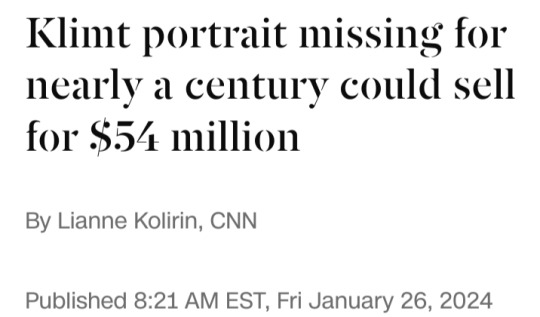
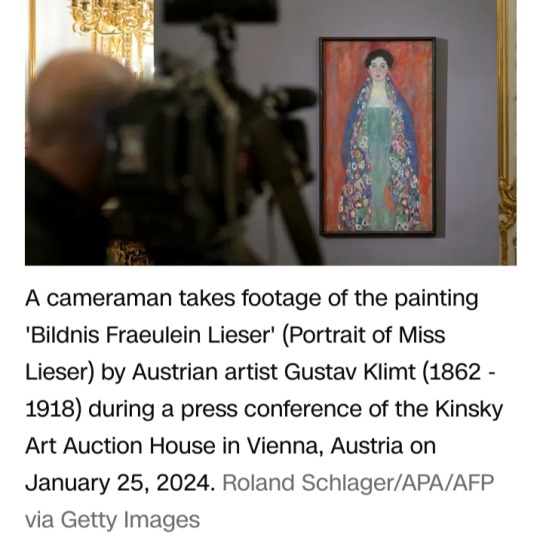
(CNN) — A portrait by Gustav Klimt that was unseen for almost a century is expected to fetch millions when it goes up for auction this spring.
The “Portrait of Fräulein Lieser,” thought to be one of the Austrian painter’s final works, is expected to fetch up to $54 million at a sale that has created huge excitement in the art world.
The painting had long been considered lost, according to Vienna auction house im Kinsky.
However, it has now emerged that it had been privately owned by an Austrian citizen.
“The rediscovery of this portrait, one of the most beautiful of Klimt’s last creative period, is a sensation,” the auction house said in a press statement on its website.
The intensely vivid and colorful piece had been documented in catalogues of the artist’s work, but experts had only seen it in a black and white photo.
The sitter is known to have been a member of a wealthy Austrian Jewish family who were then part of the upper class of Viennese society, where Klimt found his patrons and clients.
Nevertheless, her identity is not completely certain.
Brothers Adolf and Justus Lieser were leading industrialists in the Austro-Hungarian empire.
Catalogues of Klimt’s work state that Adolf commissioned the artist to paint his teenage daughter Margarethe Constance.
However, new research by the auction house suggests Justus’ wife, Lilly, hired him to paint one of their two daughters.
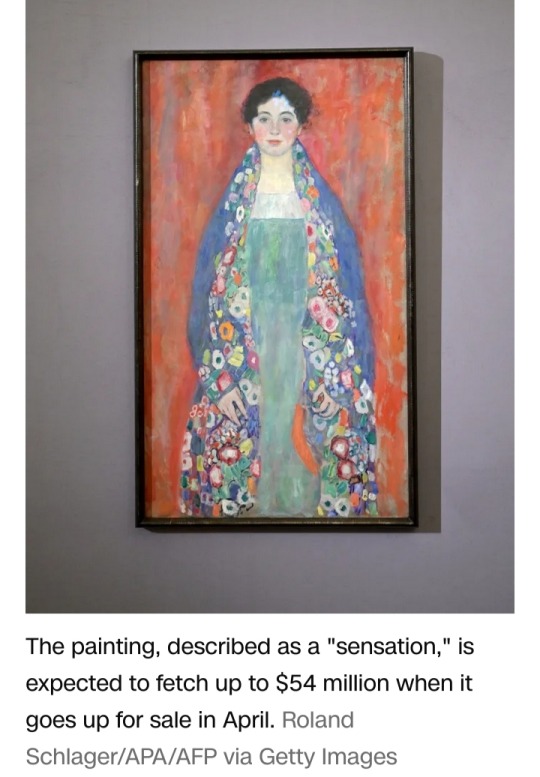
The statement on the auctioneer’s website reveals that the sitter — whoever she was — visited Klimt’s studio nine times in April and May 1917.
He made at least 25 preliminary studies and most likely began the painting in the May of that year.
“The painter chose a three-quarter portrait for his depiction and shows the young woman in a strictly frontal pose, close to the foreground, against a red, undefined background. A cape richly decorated with flowers is draped around her shoulders,” the auction house said.
It added:
“The intense colors of the painting and the shift towards loose, open brushstrokes show Klimt at the height of his late period.”
When the artist died of a stroke the following February, the painting was still in his studio - with some small parts not quite finished. It was then given to the Lieser family.
Its exact fate after 1925 is “unclear,” according to the auction house.
“What is known is that it was acquired by a legal predecessor of the consignor in the 1960s and went to the current owner through three successive inheritances,” the statement said.
"The painting is to be sold on behalf of its Austrian owners, who have not been named, along with the legal successors of 'Adolf and Henriette Lieser based on an agreement in accordance with the Washington Principles of 1998,'” the auction house said.
Established in 1998, the Washington Principles charged participating nations with returning Nazi-confiscated art to their rightful owners.
Claudia Mörth-Gasser, specialist in modern art at im Kinsky, explained the situation in an email to CNN.
She said the auctioneer checked the painting’s history and provenance “in all possible ways in Austria,” adding:
“We have checked all archives and have found no evidence that the painting has ever been exported out of Austria, confiscated or looted.
But by the same token, she added:
“We have no proof that the painting has not ever been looted in the time gap between 1938 and 1945.”
"And this is the reason why we arranged an agreement between the present owner and all descendants of the Lieser family in accordance to the ‘Washington Principles,’” she said.
Klimt’s portraits of women “are seldom offered at auctions,” the press release states.
It continues:
“A painting of such rarity, artistic significance, and value has not been available on the art market in Central Europe for decades.
The painting will tour internationally ahead of the sale on April 24, stopping in Switzerland, Germany, Britain and Hong Kong."
The last portrait completed by Klimt became the most expensive artwork ever to sell at a European auction, when it fetched a staggering £85.3 million ($108.4 million) in London last year.
Depicting an unidentified female subject, “Dame mit Fächer” (Lady with a Fan) also established a new record for Klimt, outselling “Birch Forest,” which went for $104.6 million in a sale from the collection of the late Microsoft co-founder Paul G. Allen in 2022.
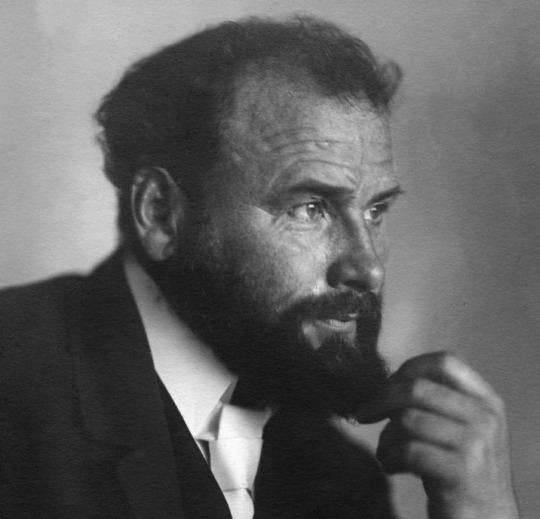
Gustav Klimt (14 July 1862 – 6 February 1918) was an Austrian symbolist painter and one of the most prominent members of the Vienna Secession movement.
#Gustav Klimt#Austria#Vienna Secession#paintings#art#Portrait of Fräulein Lieser#im Kinsky#Adolf and Justus Lieser#Margarethe Constance#Lilly#Washington Principles#Claudia Mörth-Gasser#Dame mit Fächer#Lady with a Fan#Birch Forest#Kinsky Art Auction House#Vienna#artwork
4 notes
·
View notes
Text

lost klimt portrait shows up in vienna :0
Fräulein Lieser ("Miss Lieser") has never been on public display since its creation in 1917 - you are now looking at the painting in color for (probably) the first time ever.
The current owner inherited the painting in 2022 - it originally came to be in the possession of their predecessors in the 1960s, but it is unclear how the painting came to be in the first buyer's possession. There is no information available about whether or not the painting had to be relinquished, was confiscated or sold under distress by the Lieser family after 1938. However, since the potential original owners were both forcibly dispossessed in 1938, documentation of the dispossession for this particular may have been lost.
On April 28th, the painting will be put up for auction at im Kinsky in Vienna, with the price being projected to be between 30 to 50 million euro. The legally unclear situation of whether or not the painting is Nazi-looted art is why the auction was commissioned by both the recent inheritor and the legal successors of Adolf Lieser and his sister-in-law Henriette Amelie "Lilly" Lieser, in accordance with the Washington Principles.
In the past, the depicted young woman was identified as Adolf's daughter Constance Margarethe Lieser, who would have been 18 years old during Klimt's creation of the painting. However, new research presented by the auction house im Kinsky has brought up doubts as to who the depicted "Miss Lieser" actually is. Adolf's sister-in-law Lilly Lieser, who had married and later divorced Adolf's brother Julius, was a patron of the arts and might have commissioned a painting of either of her daughters, Helene and Annie Lieser. Klimt himself never identified the commissioning customer beyond "Lieser" and died in 1918, before the painting was finished.
Lilly Lieser was a central patron of art and music in fin de siécle Vienna. She is especially well-known for her financial support of Arnold Schöneberg and was an avid art collector. For years, her best friend was Alma Mahler-Werfel. Both Adolf and Lilly Lieser were dispossessed in 1938 and later deported to Riga and/or Auschwitz, where they were murdered. Details to Margarethe's life aren't readily available, she died in London in 1943 or 44. Helene Lieser, who had been the first woman in Austria to get a PhD in political sciences, fled Austria in 1938 and ended up in Geneva. After the war, she lived in Paris, working for UNESCO, OEEC and the International Economic Association. She died from cancer in 1962 in Vienna. Annie Lieser, who was a celebrated interpretative dancer, married Austrian artist Hans Sidonius Becker. In 1938, her and their son Johann managed to flee to the US. Hans Becker was active in the Austrian resistance movement and annulled their marriage in 1941 to marry another woman. Annie probably never went back to Austria but kept contact with several other Austrian emigrants in California, among them Alma Mahler-Werfel and Luzie Korngold. She died in Los Angeles in 1972.
The painting will be shown to the public from April 10th at im Kinsky in Vienna as well as during a projected world tour to Asia, Europe and the USA.
Sources:
Olga Kronsteiner, DER STANDARD 25.01.2024
Wikipedia: Henriette Amalie Lieser, Helene Lieser, Hans Sidonius Becker
Alexandra Matzner, ART IN WORDS 25.01.2024
Valerie Gaber, im Kinsky 25.01.2024
Alexandra Löw, BiografiA Annie Becker
Anna Amilar, BiografiA Henriette Amelie Lieser, Website
Photograph of Bildnis Fräulein Lieser © Auktionshaus im Kinsky GmbH, Vienna
#gustav klimt#fräulein lieser#vienna#wien#Jugendstil#secession#austrian art#lilly lieser#adolf lieser#raubkunst#fin de siecle
64 notes
·
View notes
Text
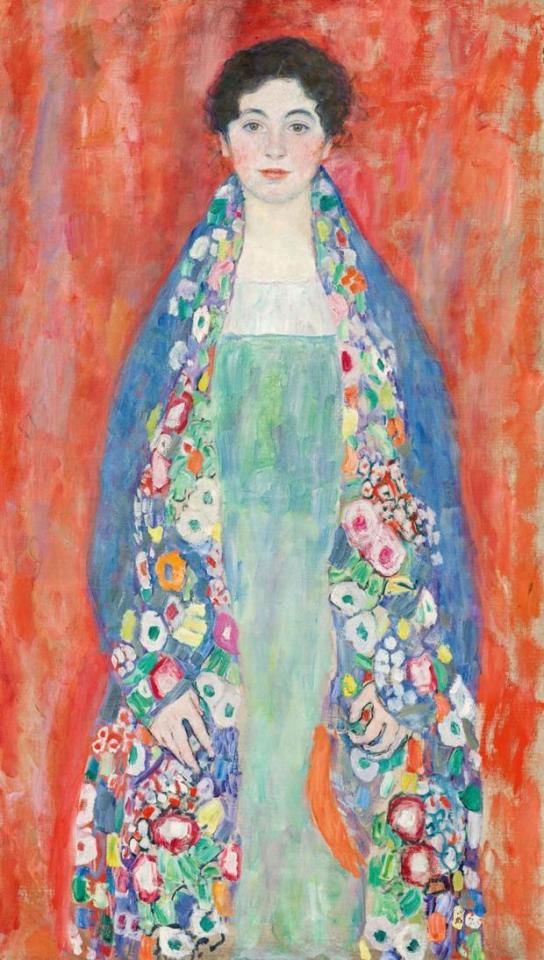
Gustav Klimt Portrait Found After Vanishing Nearly 100 Years Ago
It is one of the last works the artist painted before his death in 1918.
One of the last paintings by the renowned Austrian artist Gustav Klimt has miraculously been found after vanishing nearly 100 years ago.
The painting, titled Portrait of Fräulein Lieser, was found in Vienna after last being seen by the public in 1925. Until now, the only known photograph of the painting had been held in the archives of the Austrian National Library. The picture was likely taken in 1925 in connection with the Klimt exhibition by Otto Kallir-Nirenstein in the Neue Galerie, Vienna.
Since then, its location had been a mystery.
"The rediscovery of this portrait, one of the most beautiful of Klimt's last creative period, is a sensation," said the im Kinsky auction house in a statement announcing the discovery. "As a key figure of Viennese Art Nouveau, Gustav Klimt epitomizes fin de siècle Austrian Modernism more than any other artist. His work, particularly his portraits of successful women from the upper middle class at the turn of the century, enjoy the highest recognition worldwide."
The work of art will go up for auction at the im Kinsky auction house in Vienna on April 24 and is expected to fetch millions on the market.

"Klimt's paintings rank in the top echelons of the international art market. His portraits of women are seldom offered at auctions. A painting of such rarity, artistic significance, and value has not been available on the art market in Central Europe for decades," im Kinsky auction house said. "This also applies to Austria, where no work of art of even approximate importance has been available."
The painting will now travel worldwide on short exhibitions until it is auctioned and is set to be presented at various locations internationally, including stops in Switzerland, Germany, Great Britain and Hong Kong.
The model for the painting is labeled as Fräulein Lieser, also known as Margarethe Constance Lieser (1899-1965), daughter of the Austrian industrial magnate Adolf Lieser. But new research by the im Kinsky auction house into the history and provenance of the masterpiece has opened up the possibility that Klimt's model could have been another member of the Lieser family -- either Helene Lieser (1898-1962), the first-born of Henriette Amalie Lieser-Landau and Justus Lieser, or their younger daughter, Annie Lieser (1901-1972), according to officials.

"In April and May 1917, the sitter visited Klimt's studio in Hietzing nine times to pose for him," im Kinsky said. "Klimt probably began the painting in May 1917. The painter chose a three-quarter portrait for his depiction and shows the young woman in a strictly frontal pose, close to the foreground, against a red, undefined background. A cape richly decorated with flowers is draped around her shoulders."
The portrait is thought to be one of Klimt's last paintings and was done shortly before he died of a stroke on Feb. 6, 1918. The painting was left, with several small portions of it unfinished, in his studio and it is thought that the painting was given to the family who had commissioned it after his death.
The painting, however, would soon vanish and the exact fate of the painting after 1925 is unclear.
"What is known is that it was acquired by a legal predecessor of the consignor in the 1960s and went to the current owner through three successive inheritances," im Kinsky auction house said.
ByJon Haworth.
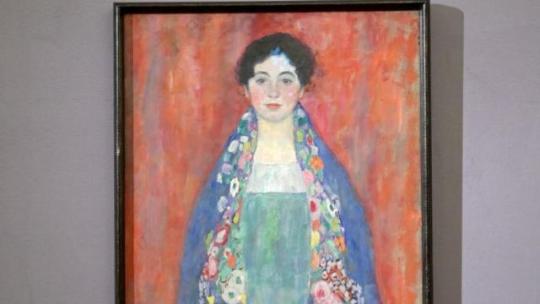
#Gustav Klimt#Gustav Klimt Portrait Found After Vanishing Nearly 100 Years Ago#Gustav Klimt Portrait of Fräulein Lieser#austrian artist#painter#painting#art#artist#art work#art world#art news#history#history news
67 notes
·
View notes
Text
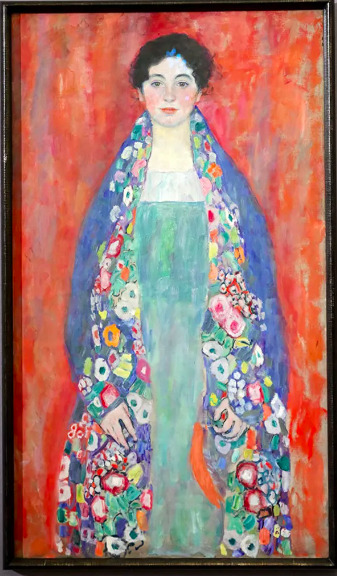
Le mystère du tableau perdu de Klimt : vendu pour 30 millions d'euros à Vienne.
Un tableau du célèbre artiste autrichien Gustav Klimt, considéré comme perdu depuis un siècle, a été vendu aux enchères à Vienne pour la somme impressionnante de 30 millions d'euros. L'œuvre inachevée, intitulée Portrait de Fraulein Lieser, a été adjugée à ce prix lors d'une vente aux enchères à Vienne.
Commandé en 1917 par une famille d'industriels juifs, un an avant la mort de Klimt, ce tableau soulève de nombreuses interrogations quant à son histoire. Qui est la femme représentée dans ce portrait ? Et qu'est-il advenu du tableau durant l'ère nazie ?
Selon les historiens de l'art Tobias Natter et Alfred Weidinger, le portrait représenterait Margarethe Constance Lieser, la fille d'Adolf Lieser. Cependant, la maison de vente aux enchères im Kinsky à Vienne suggère que le tableau pourrait également dépeindre l'une des filles de Justus Lieser et de sa femme Henriette. Cette dernière, également connue sous le nom de Lilly, était une mécène de l'art moderne, déportée par les nazis et décédée dans le camp de concentration d'Auschwitz lors de l'Holocauste.
Le tableau a été acquis dans les années 1960 par un prédécesseur légal du vendeur actuel, mais son parcours entre 1925 et cette date reste flou. Les propriétaires actuels, des Autrichiens, restent anonymes. La vente du tableau a été réalisée au nom de ces propriétaires et des successeurs légaux d'Adolf et Henriette Lieser, conformément aux Principes de Washington, un accord international visant à restituer les œuvres d'art pillées par les nazis à leurs descendants.
Malgré cette vente et les accords qui l'entourent, Erika Jakubovits, directrice exécutive de la Présidence de la Communauté juive autrichienne, estime qu'il subsiste "de nombreuses questions sans réponse" et appelle à une recherche indépendante sur cette affaire.
La restitution d'œuvres d'art revêt une grande sensibilité, et il est primordial que toute recherche soit menée avec précision et transparence, afin d'assurer des procédures équitables pour les restitutions privées futures.
0 notes
Text
Il Klimt ritrovato a Vienna, i nazisti e l’asta dei misteri. “Non vendete il ritratto della signorina Lieser”
VIENNA – Nel 1917 Margarethe Constance Lieser è costretta a posare per nove volte nello studio viennese di Gustav Klimt. Farsi ritrarre dal grande pittore dello Jugendstil significa anzitutto armarsi di una grande pazienza. La diciottenne dai grandi occhi bruni viene dipinta su uno sfondo arancione, il vestito è un profluvio di colori: il quadro è uno degli ultimi capolavori di Klimt,…
View On WordPress
#aggiornamenti da Italia e Mondo#Mmondo#Mmondo tutte le notizie#mmondo tutte le notizie sempre aggiornate#mondo tutte le notizie
0 notes
Text
Gustav Klimt Portrait Found After Vanishing Nearly 100 Years Ago
It is One of the Last Works the Artist Painted Before his Death in 1918.
— By Jon Haworth | Published: January 26, 2024
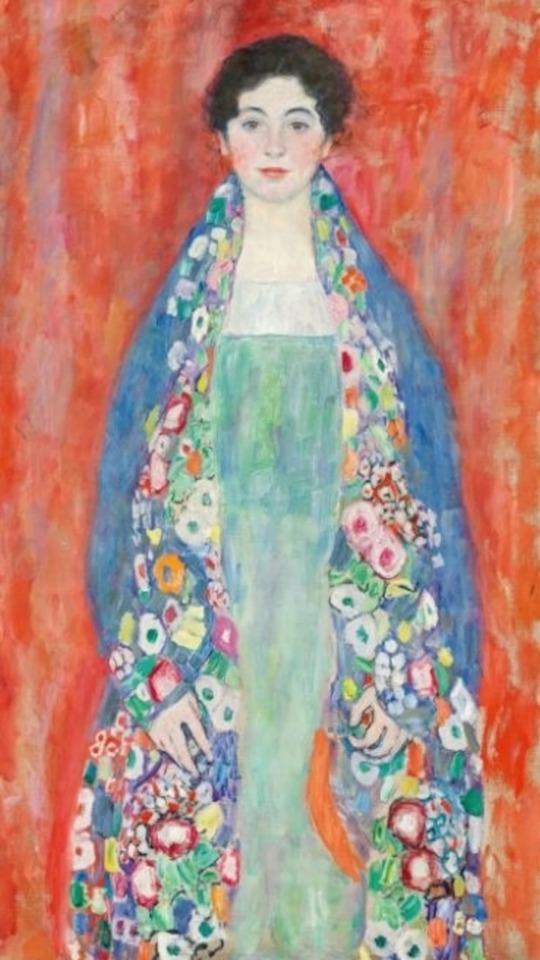
Gustav Klimt's Portrait of Fräulein Lieser. im Kinsky Auction House
LONDON — One of the last paintings by the renowned Austrian artist Gustav Klimt has miraculously been found after vanishing nearly 100 years ago.
The painting, titled Portrait of Fräulein Lieser, was found in Vienna after last being seen by the public in 1925. Until now, the only known photograph of the painting had been held in the archives of the Austrian National Library. The picture was likely taken in 1925 in connection with the Klimt exhibition by Otto Kallir-Nirenstein in the Neue Galerie, Vienna.
Since then, its location had been a mystery.
"The rediscovery of this portrait, one of the most beautiful of Klimt's last creative period, is a sensation," said the im Kinsky auction house in a statement announcing the discovery. "As a key figure of Viennese Art Nouveau, Gustav Klimt epitomizes fin de siècle Austrian Modernism more than any other artist. His work, particularly his portraits of successful women from the upper middle class at the turn of the century, enjoy the highest recognition worldwide."
The work of art will go up for auction at the im Kinsky auction house in Vienna on April 24 and is expected to fetch millions on the market.

A cameraman takes footage of the painting Bildnis Fraeulein Lieser (Portrait of Miss Lieser) by Austrian artist Gustav Klimt (1862-1918) during a press conference of the Kinsky Art Auction House in Vienna, on Jan. 25, 2024. Roland Schlager/APA/AFP via Getty Images
"Klimt's paintings rank in the top echelons of the international art market. His portraits of women are seldom offered at auctions. A painting of such rarity, artistic significance, and value has not been available on the art market in Central Europe for decades," im Kinsky auction house said. "This also applies to Austria, where no work of art of even approximate importance has been available."
The painting will now travel worldwide on short exhibitions until it is auctioned and is set to be presented at various locations internationally, including stops in Switzerland, Germany, Great Britain and Hong Kong.
The model for the painting is labeled as Fräulein Lieser, also known as Margarethe Constance Lieser (1899-1965), daughter of the Austrian industrial magnate Adolf Lieser. But new research by the im Kinsky auction house into the history and provenance of the masterpiece has opened up the possibility that Klimt's model could have been another member of the Lieser family -- either Helene Lieser (1898-1962), the first-born of Henriette Amalie Lieser-Landau and Justus Lieser, or their younger daughter, Annie Lieser (1901-1972), according to officials.

"In April and May 1917, the sitter visited Klimt's studio in Hietzing nine times to pose for him," im Kinsky said. "Klimt probably began the painting in May 1917. The painter chose a three-quarter portrait for his depiction and shows the young woman in a strictly frontal pose, close to the foreground, against a red, undefined background. A cape richly decorated with flowers is draped around her shoulders."
The portrait is thought to be one of Klimt's last paintings and was done shortly before he died of a stroke on Feb. 6, 1918. The painting was left, with several small portions of it unfinished, in his studio and it is thought that the painting was given to the family who had commissioned it after his death.
The painting, however, would soon vanish and the exact fate of the painting after 1925 is unclear.
"What is known is that it was acquired by a legal predecessor of the consignor in the 1960s and went to the current owner through three successive inheritances," im Kinsky auction house said.
0 notes
Text
IPO UPDATE
IPO Update for summative. Amendment #2
Intent: (50-100 words):
In one or two sentences describe your intention: what your interests are, what will you make art “about”.
I’m very intrigued with the senses, more specifically touch and how it enhances our connections with others and our surroundings. I’m interested in exploring the sensation of touch (figuratively and literally) and its relation to memories and self through skin and the body. I want the work I create this year to convey the impressions of touch and how it embodies our experiences and memories within this world. I believe we are who we are because of the experiences we have lived. My touch is a physical expression of my identity and self and I think making it visual is an exploration I’d like to look into.
Background: (200-300 words):
Briefly describe what you did last semester, what you intend to develop from this work, and what (if anything) you are not going to continue to work with.
Last year my work focused on touch and the embodiment of our identity and emotions through the process of mark making and line. I also explored light and shadows and their relation to emotion. Using thin sheets of plastic, I etched self portraits into the sheets and then layered them together with frames. They created a ‘tunnel’ of my mark making and self, the portraits only visible when you looked through the layers at a certain angle with certain lighting.
I’m still interested in touch and the relationship between touch, ourselves and others and I’d like to develop my knowledge in the subject, however I’d like to portray it more literally. I’m hoping to make the connection to tactility more direct and visually overwhelming. Last year I went out of my comfort zone exploring a lot of mediums like the etching and the use of plastic. This year I’d like to return to painting to create my work.
I’ve decided I’m not going to continue with the etching into plastic, the focus on the actual physical line and act of mark making, as well as the connection to emotions and the exploration into light and shadow.
Method and resources: (100-200 words):
What do you intend to make (i.e., painting, sculpture, video, etc., etc.), and how (materials and processes). Do you need an individual studio space or can you use the shared space? What knowledge and skills do you need to gain, and what investigations do you plan to undertake?
I’m wanting to expand my experience and knowledge of paint by painting my work and ideas this semester. Even if I’m using a tool or brush to paint, the touch through the action and gesture of painting will help me create work that’s meant to intensify a connection to our senses, tactility and memory. I’d like to explore oil paint in works that require painting body or skin as I like how it can be manipulated and smoothed into different textures and I think it mimics skin really well. I’m also interested in using my hands and thicker paints and mediums like modeling paste, if I’m exploring touch and sensation, there’s not really any easier way to experience it apart from directly using my hands. I think abstract expressionism and styles like impasto and tachisme will be important in creating tactile and textural works - using these styles and ideas will also require some research.
I think for my idea, different scales will create different readings of the work. I’d like to explore a smaller ‘canvas’ and make the work quite intimate but I think I’d like progress to work bigger and really overwhelm the audience with the sensation of touch. I could use quite a few materials to create larger scale work like a sheet of MDF or plywood etc but I have always wanted to paint on un-stretched canvas. I think it holds a lot of possibilities for manipulation ect If I wanted to do something to it, unlike a canvas that has already been stretched onto bars. The canvas texture can also look quite similar to skin.
I have very basic knowledge of oil paint but I need to learn how to properly look after my tools when using the medium and how to work with the medium better when blending and mixing etc. For larger scale works maybe more specifically if I were to use my hands, I think I’d need to practice not being so restricted and hesitant when creating work and not being afraid of what it looks like. Not all art is pretty!
I’m going to need to gain knowledge on artists that use the body, create abstract and textural works and draw from memory and identity.
Schedule:
Produce a timeline of the above. Some key dates/events have already been populated:
Week 1: Research and brainstorming and add to workbook
Week 2: Reflect on work from last year, research artist models, explore different techniques and mediums, add to workbook
Week 3: Draft IPO due Tues Mar 9, First group crit Fri Mar 12, start creating work for crit and more research and add to workbook
Week 4: create work and more explorations and add to workbook
Week 5: Formative assessment crits Fri Mar 26, create work, investigations and clarify ideas. Finish work for formative. and add to workbook
Week 6: reflect on feedback from formative, progress, and add to workbook
Study Break: visit galleries - search for inspiration - work on painting techniques
Week 7: Brainstorm continuation, reflect on formative feedback, research, and add to workbook
Week 8: Start creating final work/s, research and add to workbook
Week 9: Continue making final work for crit week and add to workbook
Week 10: Crit Week , reflect on feedback and add to workbook
Week 11: Finalise work for hand in/make new work and add to workbook - update IPO
Week 12: Final hand in Tue May 25
References:
Begin a list of a minimum of 6 references, four of which must be artists or artworks whose work is inspirational and whom you intend to continue to use to develop your own work, and two other references (text, music, film, other writing, etc.) Briefly describe how each reference is relevant to your own intended research.
Reference both texts and artwork images properly: you should use the system recommended for visual material on OWLL, which includes the artist’s name, the date of the artwork and a URL, book or exhibition note.
Jean Dubuffet - I like how Dubuffet challenges the idea of ‘beautiful art’. I’ve been struggling to accept the idea of finger-painting in art school so it’s nice to see the success of Dubuffet’s work and his process.

Dubuffet, Jean. Site habité d’objets, 1965, Barbican Art Gallery, London, https://www.tate.org.uk/art/artworks/dubuffet-site-inhabited-by-objects-t00870
Yves Klein - I’m really interested in Klein’s idea of anthropometry and I think it has an interesting correlation with touch, tactility and the body. I also like his use of him famous blue paint.

Klein, Yves. Anthropometry: Princess Helena, 1960, Not on view, https://www.moma.org/collection/works/80530
Jackson Pollock - Pollock’s texture and abstraction is something I think can be related to my own ideas and practice at the moment. His process also really interests me, I think the controversy surrounding his practice is interesting too.

Pollock, Jackson. Number 23, 1948, Not on display, Tate, https://www.tate.org.uk/art/artworks/pollock-number-23-t00384
Anselm Kiefer - The way Kiefer’s comes off the canvas/page is a really engaging aspect of his work and I’d like my own work to have similar affects with the viewer with my use of modeling paste and paint.

Kiefer, Anselm. Margarethe, 1981, SFMoMA,
https://www.sfmoma.org/artwork/FC.595/
Gerhard Richter - I feel myself drawn to Richters work, mostly the blurred paintings or photographs he created. The blurred technique makes me think of memories that are fading, always there but never 100% can remember all the details. I often think about the blurring technique relaying a touch that is missed or craved.

Richter, Gerhard. Sailors. 1966, Oil on Canvas, Gerhard Richter, https://www.gerhard-richter.com/en/art/paintings/photo-paintings/everyday-life-18/sailors-5764
Jenny Saville - Her visceral, thick paintings of flesh make me experience them through my own senses, every though I can only visually see them through a screen. I love the 3D texture that she gives the forms and body.

Saville, Jenny. Rosetta 2. 2005-2006, Oil on watercolour paper mounted on board, Jenny Saville, https://gagosian.com/artists/jenny-saville/.
Emilie Louise Gossiaux - Relying on the senses like touch and using memories to create work. Creating by feeling.

Gossiaux, Emilie Louise. After Image. 2018, unknown medium, Emilie Louise Gossiaux, http://www.emiliegossiaux.com/after-image/.
Classen, Constance. The Book of Touch. Routledge, Taylor & Francis Group, 2020. - Explores tactile sensations and touch with boundaries and experiences.
Fowler, Caroline O. Drawing And The Senses: An Early Modern History. Turnhout, Belgium, 2016. - How touch and senses were expressed through drawing earlier in history.
Resources:
Do you need a studio space, and/or access to any particular equipment? What kinds of materials do you think you will be using and where and how you will get these? Identify any health and safety issues (and how you intend to deal with these issues), This will probably take the form of an annotated list.
For summative :
Big canvas 2 x 160m
Modeling paste - 1L
Palette knives
Acrylic paint - several tubes of each colour or bigger bottles of each
Nails and hammer
Access to nice printer to print reference image
Artist pins/really thin and small nails to hang photo
Level
Drop sheet or something to protect floor
Old clothes
Wipes and or towel or paper towels
Access to water to wash hands and tools
Studio space = desk and wall.
Oil paint and appropriate solvents/oils etc - be safe when using the solvents (inhalation, skin)
Canvases and brushes
0 notes
Photo




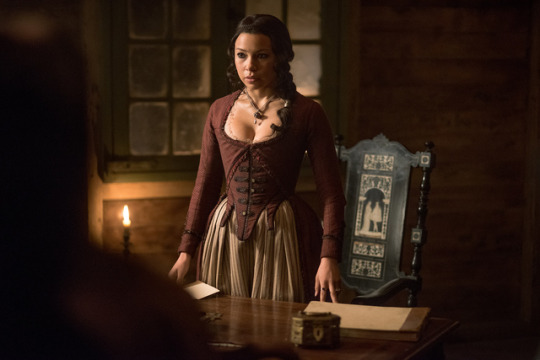


I was thinking about fem Bilbo (and fem bagginshield) and possible actresses to use as a reference.
1. Daniela Denby-Ashe as Margareth Hale (North & South)
I must admit that I’ve never watched North&South, but the actress looks very appropriate! Plus she gets to smooch Richard Armitage, you go girl.
2. Jessica Parker Kennedy as Max (Black Sails)
Resourceful and with a preference for bright-coloured dresses. When I found the fist picture I thought that also Eleanor (the blonde woman) could work, but I must admit that two quotes in particular made me choose Max:
You are the bravest person I ever known, the truest person I ever known, and I betrayed you and it sickens me.
I loved you and I betrayed you [...] I do not wish to lie to you evere again. I am going to stay with you. I want to take care of you.
Both of them works pretty well for a certain canon scene...
3. Tamla Kari as Constance (The Musketeers)
A brave and smart woman (that looks lovely in floral patterns btw) who yearns for a more adventurous life.
Now a fem Thorin! I just have to find an actress/model/whatever that I could imagine with a beard and bushy eyebrows. Nice!
#fem bilbo#fem bagginshield#ah yes obviously with fem bilbo i totally mean also trans woman bilbo#everyone is included here#fembagginshield
28 notes
·
View notes
Text
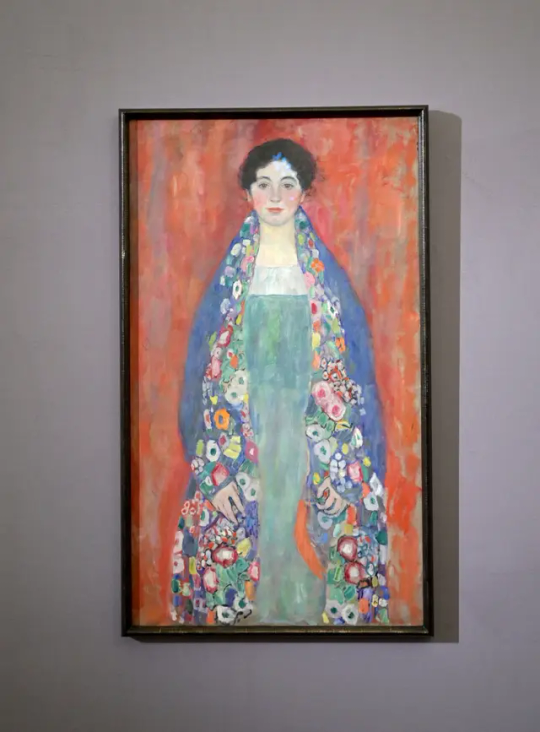
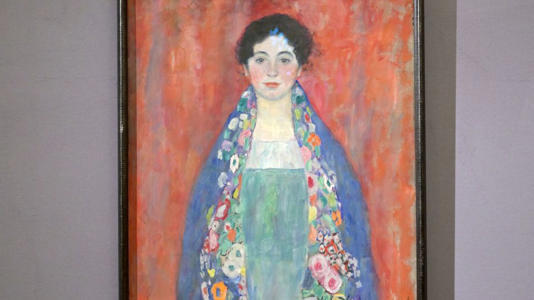
Gustav Klimt Portrait Missing for a Century Sells for $32 Million
A portrait by Gustav Klimt that was unseen for almost a century has sold for $32 million – the bottom end of its pre-auction estimate.
The “Portrait of Fräulein Lieser,” thought to be one of the Austrian painter’s final works, created huge excitement in the art world, but it ended up selling at the lower end of its valuation of €30 million-€50 million ($32 million to $53.4 million).
Bids started at €28 million and the work went for a hammer price of €30 million. This does not include the auction house’s fees.
The sale price was less than half that fetched by another Klimt painting – “Dame mit Fächer” (Lady with a Fan) – in London last year. The last portrait completed by Klimt became the most expensive artwork ever to sell at a European auction, when it sold for a £85.3 million ($108.4 million).
The “Portrait of Fräulein Lieser” had long been considered lost, according to Vienna auction house im Kinsky. However, it recently emerged that it had been privately owned by an Austrian citizen.
“The rediscovery of this portrait, one of the most beautiful of Klimt’s last creative period, is a sensation,” the auction house said in a press statement on its website prior to its sale on Wednesday afternoon.
The intensely vivid and colorful piece had been documented in catalogues of the artist’s work, but experts had only seen it in a black and white photo.
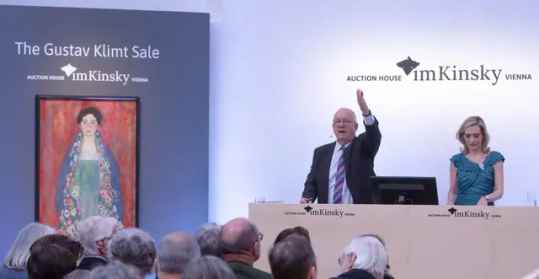
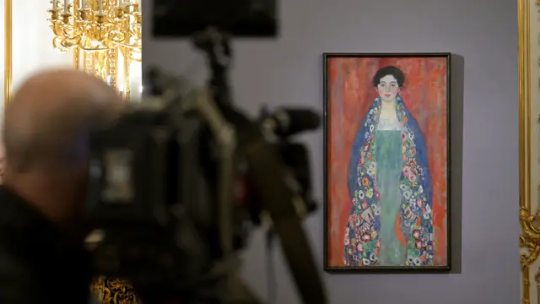
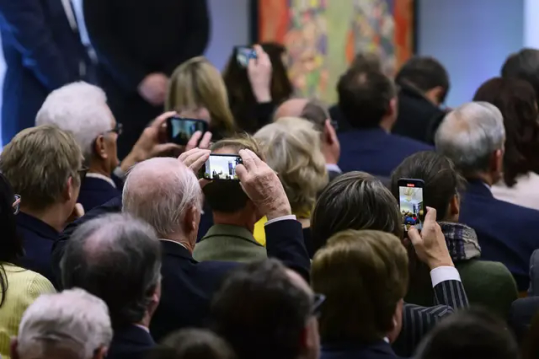
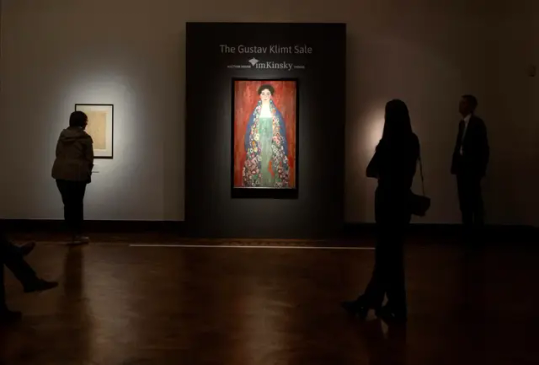
The sitter is known to have been a member of a wealthy Austrian Jewish family who were then part of the upper class of Viennese society, where Klimt found his patrons and clients. Nevertheless, her identity is not completely certain.
Brothers Adolf and Justus Lieser were leading industrialists in the Austro-Hungarian empire. Catalogues of Klimt’s work state that Adolf commissioned the artist to paint his teenage daughter Margarethe Constance. However, new research by the auction house suggests Justus’ wife, Lilly, hired him to paint one of their two daughters.
The statement on the auctioneer’s website reveals that the sitter – whoever she was – visited Klimt’s studio nine times in April and May 1917. He made at least 25 preliminary studies and most likely began the painting in the May of that year.
“The painter chose a three-quarter portrait for his depiction and shows the young woman in a strictly frontal pose, close to the foreground, against a red, undefined background. A cape richly decorated with flowers is draped around her shoulders,” the auction house said.
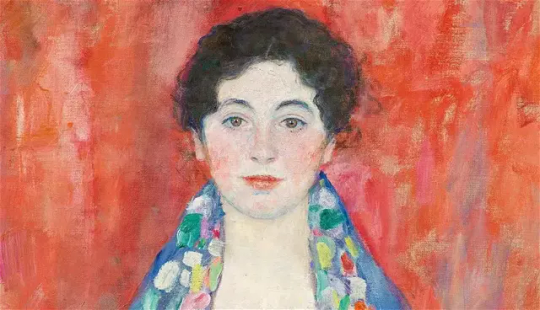
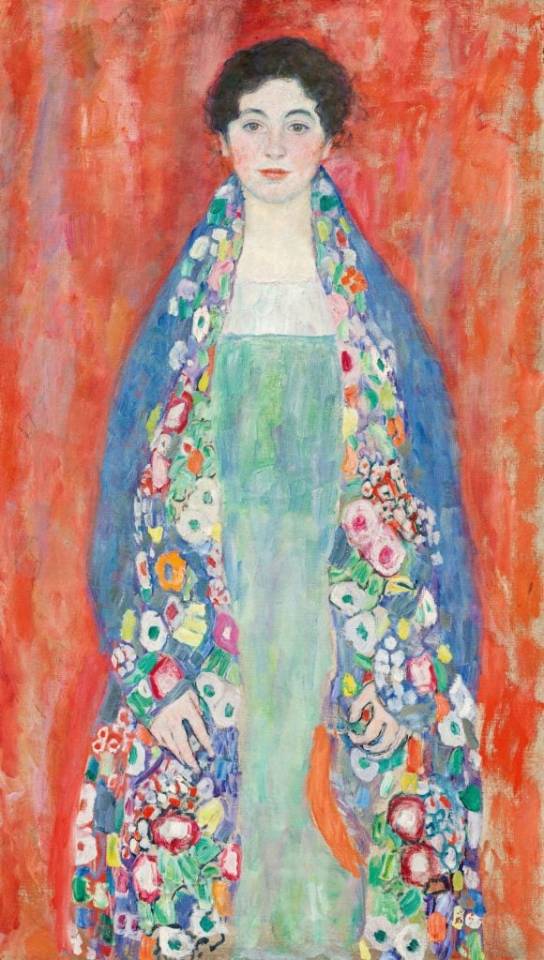
It added: “The intense colors of the painting and the shift towards loose, open brushstrokes show Klimt at the height of his late period.”
When the artist died of a stroke the following February, the painting was still in his studio — with some small parts not quite finished. It was then given to the Lieser family.
Its exact fate after 1925 is “unclear,” according to the auction house.
“What is known is that it was acquired by a legal predecessor of the consignor in the 1960s and went to the current owner through three successive inheritances,” the statement said.

The painting was to be sold on behalf of its Austrian owners, who have not been named, along with the legal successors of “Adolf and Henriette Lieser based on an agreement in accordance with the Washington Principles of 1998,” the auction house said.
Established in 1998, the Washington Principles charged participating nations with returning Nazi-confiscated art to their rightful owners.
Claudia Mörth-Gasser, specialist in modern art at im Kinsky, explained the situation in an email.

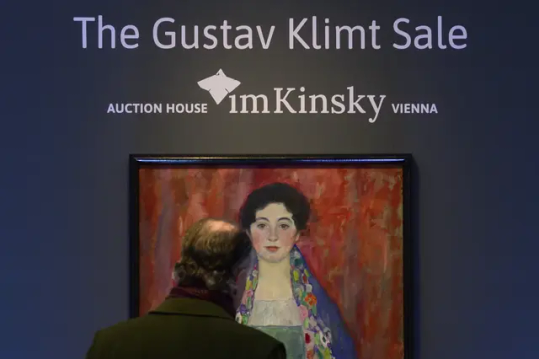
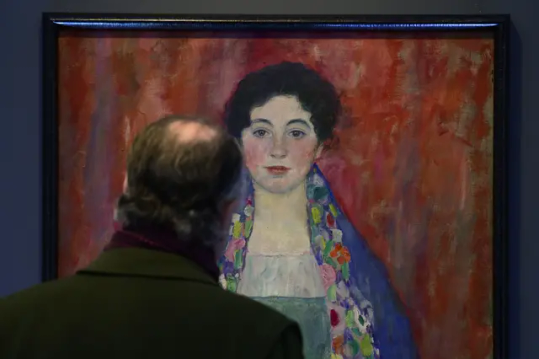
She said the auctioneer checked the painting’s history and provenance “in all possible ways in Austria,” adding: “We have checked all archives and have found no evidence that the painting has ever been exported out of Austria, confiscated or looted.”
But by the same token, she added: “We have no proof that the painting has not ever been looted in the time gap between 1938 and 1945.”
And this is the reason “why we arranged an agreement between the present owner and all descendants of the Lieser family in accordance to the ‘Washington Principles,’” she said.
Klimt’s portraits of women “are seldom offered at auctions,” the press release stated. It continued: “A painting of such rarity, artistic significance, and value has not been available on the art market in Central Europe for decades.”
By Lianne Kolirin.

#Gustav Klimt#Gustav Klimt 'Portrait of Fräulein Lieser'#Gustav Klimt Portrait Missing for a Century Sells for $32 Million#austrian artist#painter#painting#art#artist#art work#art world#art news
12 notes
·
View notes